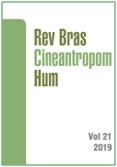Longitudinal follow-up of physical activity from preschool to school age: the ELOS-Pré study
DOI:
https://doi.org/10.1590/1980-0037.2019v21e59242Abstract
The aim of this study was to verify if the practice of physical activity in the preschool age (3-5 years) is predictive of this behavior after entering the school age (5-7 years). A longitudinal, school-based study with 700 children enrolled in public and private schools of the city of Recife, Pernambuco, who were evaluated in 2010 and followed in 2012. The study variables were the time spent in outdoor games and plays (a measure referred to by the parents / guardians of children through questionnaire applied as an interview) and the level of physical activity (objective measure obtained by the Actigraph accelerometer). The latter measure was extracted from a subsample (n = 98) of children. To analyze data, binary logistic regression was used. Children who spent 60+ minutes per day in this type of activity were 45% more likely of maintaining this behavior after entering the school age (OR = 1.45, 95% CI 1.02-2.07, p = 0.04). In addition, children who presented global NAF measure of 300+ counts / minute in 2010 were 173% more likely of maintaining this level of physical activity after entering the school age (OR = 2.73, 95% CI, 98-7.59, p = 0.06). It was verified that the practice of physical activity in the preschool age is a predictor of this behavior after entering the school age. It is suggested the development of campaigns to inform parents and teachers about the importance of early adherence to physical activity recommendations.
References
Hnatiuk JA, Salmon J, Hinkley T, Okely AD, Trost S. A review of preschool children’s physical activity and sedentary time using objective measures. Am J Prev Med 2014;4(4):487-497.
Reilly JJ, Jackson DM, Montgomery C, Kelly LA, Slater C, Grant S, et al. Total energy expenditure and physical activity in young Scottish children: mixed longitudinal study. Lancet 2004;363(9404):211-212.
Kelly LA, Reilly JJ, Grant S, Paton JY. Low physical activity levels and high levels of sedentary behaviour are characteristic of rural Irish primary school children. Ir Med J 2005;98(5):138-141.
Barros SSH, Lopes AS, Barros MVG. Prevalência de baixo nível de atividade física em crianças pré-escolares. Rev Bras Cineantropom Desempenho Hum 2012;14(4):390-400.
Wanderley Júnior RS, Hardman CM, Oliveira ESA, Brito ALS, Barros SSH, Barros MVG. Fatores parentais associados à atividade física em pré-escolares: a importância da participação dos pais em atividades físicas realizadas pelos filhos. Rev Bras Ativ Fis Saúde 2013;18(2):205-214.
Timmons BW, Leblanc AG, Carson V, Connor Gorber S, Dillman C, Janssen I, et al. Systematic review of physical activity and health in the early years (aged 0-4 years). Appl Physiol Nutr Metab 2012;37(4):773-792.
Tomporowski PD, Davis CL, Miller PH, Naglieri JA. Exercise and children’s intelligence, cognition, and academic achievement. Educ Psychol Rev 2008;20(2):111-131.
Singh JA, Furst DE, Bharat A, Curtis JR, Kavanaugh AF, Kremer JM. 2012 Update of the 2008 American College of Rheumatology recommendations for the use of disease-modifying antirheumatic drugs and biologic agents in the treatmentof rheumatoid arthritis. Arthritis Care Res 2012;64(5):625-639.
Telama R, Yang X, Leskinen E, Kankaanpää A, Hirvensalo M, Tammelin T, et al. Tracking of physical activity from early childhood through youth into adulthood. Med Sci Sports Exerc 2014;46(5):955-962.
Dumith SC, Gigante DP, Domingues MR, Kohl HW 3rd. Physical activity change during adolescence: a systematic review and a pooled analysis. Int J Epidemiol 2011; 40(3):685-698.
Luiz RR, Magnanini MMF. A lógica da determinação do tamanho da amostra em investigações epidemiológicas. Cad Saúde Colet 2000;8(2):9-28.
Trost SG, Loprinzi PD, Moore R, Pfeiffer KA. Comparison of accelerometer cut points for predicting activity intensity in youth. Med Sci Sports Exerc 2011;43(7):1360-1368.
Francis SL, Morrissey JL, Letuchy EM, Levy SM, Janz KF. Ten-year objective physical activity tracking: Iowa Bone Development Study. Med Sci Sports Exerc 2013;45(8):1508-1514.
Cain KL, Sallis JF, Conway TL, Van Dyck D, Calhoon L. Using accelerometers in youth physical activity studies: a review of methods. J Phys Act Health 2013;10(3):437-450.
Lima RA, Barros SSH, Cardoso Júnior CG, Silva G, Farias Júnior JC, Andersen LB, et al. Influence of number of days and valid hours using accelerometry on the estimates of physical activity level in preschool children from Recife, Pernambuco, Brazil. Rev Bras Cineantropom Desempenho Hum 2014;16(2):171-181.
Kari JT, Tammelin TH, Viinikainen J, Hutri-Kähönen N, Raitakari OT, Pehkonen J. Childhood physical activity and adulthood earnings. Med Sci Sports Exerc 2016;48(7):1340-1346.
Corder K, Winpenny E, Love R, Brown HE, White M, Sluijs EV. Change in physical activity from adolescence to early adulthood: a systematic review andmeta-analysis of longitudinal cohort studies. Br J Sports Med (in press).
Caldwell HA, Proudfoot NA, King-Dowling S, Di Cristofaro NA, Cairney J, Timmons BW. Tracking of physical activity and fitness during the early years. Appl Physiol Nutr Metab 2016;41(5):504-510.
Edwards NM, Khoury PR, Kalkwarf HJ, Woo JG, Claytor RP, Daniels SR. Tracking of accelerometer-measured physical activity in early childhood. Pediatr Exerc Sci 2013; 25(3):487-501.
Kelly LA, Reilly JJ, Jackson DM, Montgomery C, Grant S, Paton JY. Tracking physical activity and sedentary behavior in young children. Pediatr Exerc Sci 2007;19(1):51-60.
Pate RR, Baranowski T, Dowda M, Trost SG. Tracking of physical activity in young children. Med Sci Sports Exerc 1996;28(1):92-96.
Potter M, Spence JC, Boulé N, Stearns JA, Carson V. Behavior tracking and 3-year longitudinal associations between physical activity, screen time, and fitness amongyoung children. Pediatr Exerc Sci 2018;30(1):132-141.
Taylor RW, Murdoch L, Carter P, Gerrard DF, Williams SM, Taylor BJ. Longitudinal study of physical activity and inactivity in preschoolers: the FLAME study. Med Sci Sports Exerc 2009;41(1):96-102.
Jones RA, Hinkley T, Okely AD, Salmon J. Tracking physical activity and sedentarybehavior in childhood: a systematic review. Am J Prev Med 2013;44(6):651-658.
Rauner A, Jekauc D, Mess F, Schmidt S, Woll A. Tracking physical activity in different settings from late childhood to early adulthood in Germany: the MoMo longitudinal study. BMC Public Health 2015;17;15:391.
Sigmund E, Sigmundová D, El Ansari W. Changes in physical activity in preschoolers and first-grade children: longitudinal study in the Czech Republic. ChildCare Health Dev 2009;35(3):376-82.



